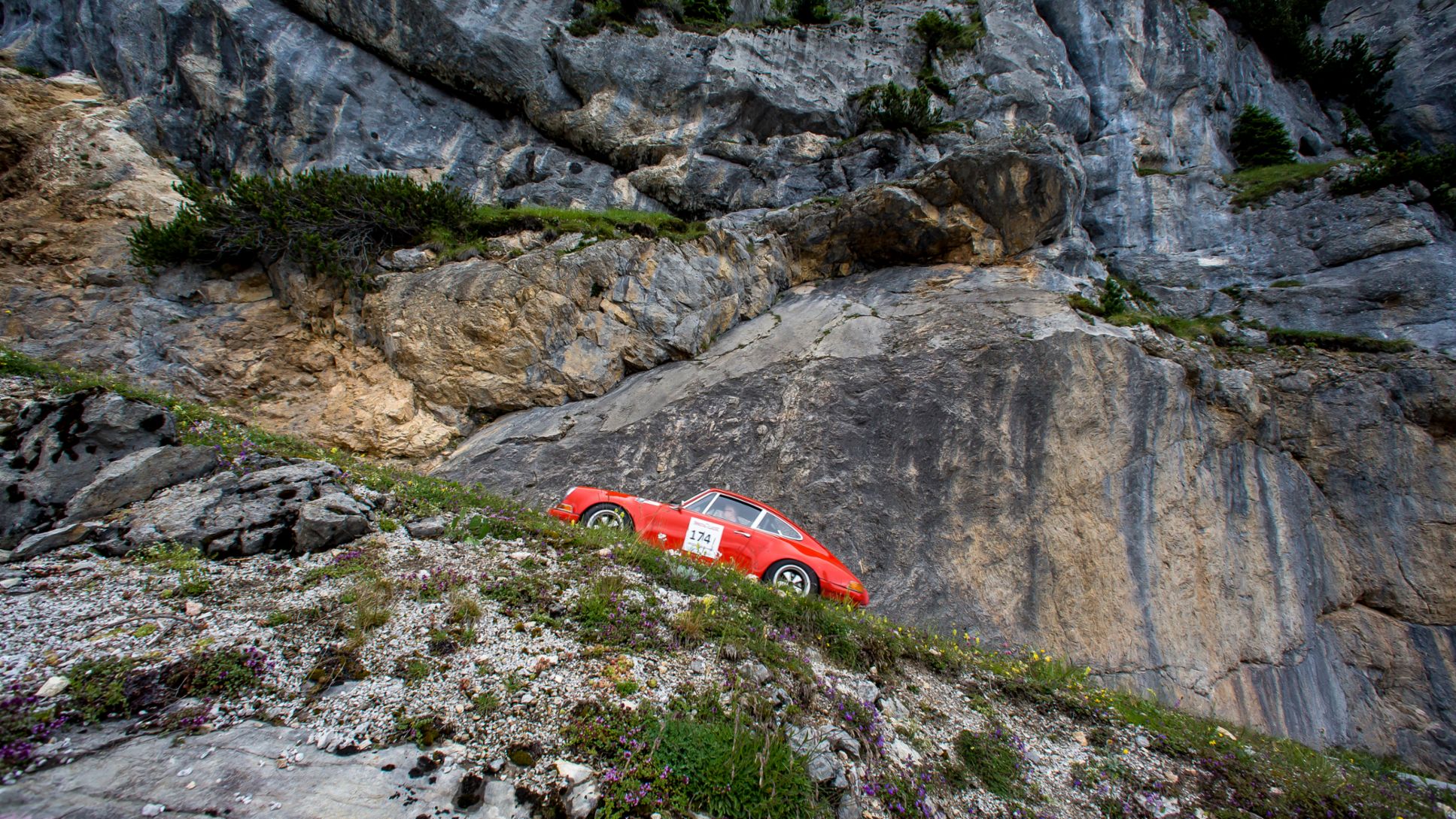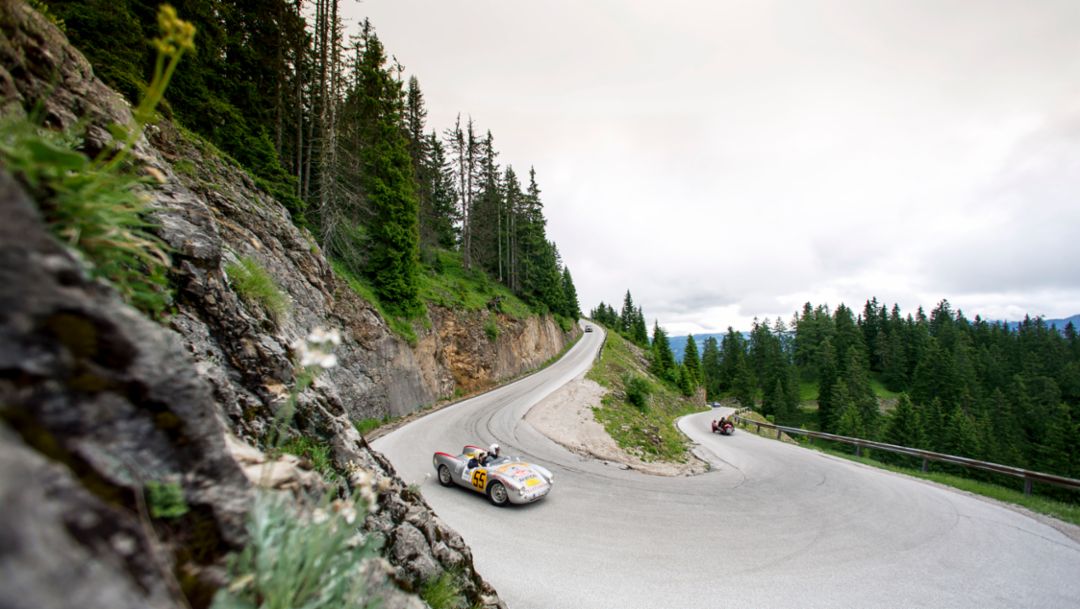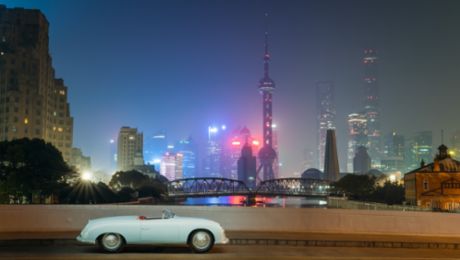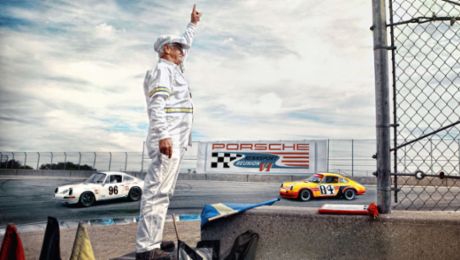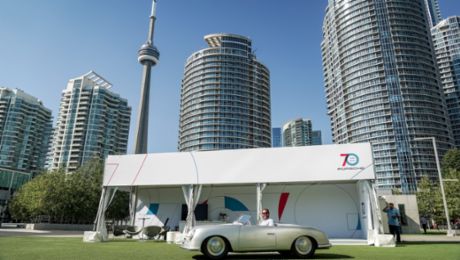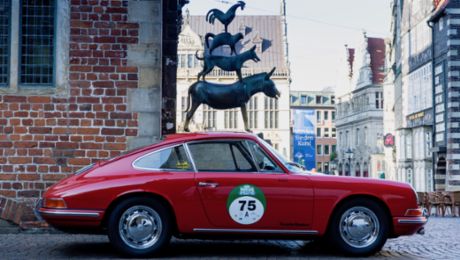The Porsche 356 rolls slowly down the start ramp. It’s just after eight in the morning. Despite the early hour, throngs of spectators line the street from Gröbming in Styria’s Ennstal Valley as it runs toward Stoderzinken. Andreas Kainer listens intently to the uniform sounds from the compact four-cylinder Boxer motor, then casts an expert eye over the sports car’s instrument panel – everything seems fine.
He’s giddy with anticipation about what lies ahead, and a bit worked up as well: the Ennstal-Classic is slated to see his 356 Coupé make a triumphant return to the streets after extensive restorations. Kainer fiddles a bit with the gas pedal, checks the precision of the steering and gets a feel for how the tires are gripping the roadway. His co-pilot gives the thumbs up sign from the passenger seat, followed by a broad grin. The experienced team approaches the start line for the first special review of this Ennstal-Classic – and then his 356 passes through the light barrier at the foot of the mountain. Their route will take them 8,258 metres in total along the winding (and closed) road to Stoderzinken.
“The starting field gets more interesting every year.”
The goal is not to go as fast as possible, but rather as precisely as possible at the proscribed average speed of 48.2 km/h, all documented through a merciless set of timing checkpoints. Kainer is responsible for keeping the car rolling smoothly and steadily, while his colleague keeps a mechanical stopwatch running to help get the timing just right. They move quickly up the 2,000-metre mountain, and after roughly ten minutes they trip the light barrier and head for the Rossfeld parking lot. They’ve gathered crucial data: the drive was smooth, but slightly under optimal conditions. Even so, ground has been broken for this year’s running of the classic car event.
“When we held the event for the first time back in 1993, we drew our line in the sand at 1972 models, because from our vantage point there are just so many fascinating cars built before then,” explains organizer Michael Glöckner. “And we just ended up leaving it there. One side effect: the starting field gets older and as such more interesting every year.” Glöckner, formerly a motorsports photographer and tourism director in Gröbming, created the Ennstal-Classic in collaboration with Formula 1 journalist Helmut Zwickl. “The mix of competitive driving, grand landscapes, Austrian hospitality and relaxed shop talk are what make the Ennstal-Classic special,” Zwickl says. “Where else can you find this kind of combination?”
This is precisely the recipe cooked up by the Ennstal-Classic – primary sponsor since 2014: Porsche. Fans flock to the event. Some love the idea of piloting their own old-timer through carefully selected, low-traffic streets across four Austrian provinces – the number of applications far outstrips the capacity every year. Others look forward to standing at the start, finish or way stations of this rolling museum.
On the hunt for special moments
2014 marks Andreas Kainer’s fourth year in the race. He’s already returned back from Stoderzinken, following a carefully laid-out route that runs along the Nockalm and the Turracher Höhe toward the Red Bull Ring in Spielberg, one of the further highlights of the day. His sports car, built in 1955 in Zuffenhausen, is the oldest 356 in the field, and the second-oldest Porsche: a 550 Spyder from the factory museum rolled across the start line a few minutes ahead of him.
Kainer thinks the silver racer is somewhere around the next crest, ahead of other classic cars, and hopes at some point in the day to follow in its slipstream. It remains to be seen whether it’ll happen. But the fun is already well underway: he’s become one with his driving machine, flowing through curves and switchbacks in an ideal rhythm. “When I get in the zone like this, I become a hunter of special moments,” he says, eyes blazing. “Out here you find them on nearly every metre of pavement.”
The 365 in the extremely rare Bent-Window Pre A Continental version approaches a curve. Kainer double-clutches into third and then back down into second gear. The needle on the tachometer hangs at roughly 3,000 rpm. Following the ideal line precisely, he heads first right, then immediately left through the next straightaway. Kainer depresses the gas and the Boxer motor responds. “The car is happy when it can rev to between 3,000 and 5,000 rpm. It runs more or less on its own then. But you have to trust it and let it carry that speed, because otherwise it won’t have the power in the mountains to accelerate going uphill.”
Prominent drivers at the starting line
Extraordinary moments are par for the course at the Ennstal-Classic – from the landscape, from the cars, from the discussions. It doesn’t hurt that there’s a high density of prominent rally and racing drivers on hand, lured by the charms of the event and the classic cars they’ll be piloting along the course. A small “Who’s Who” of elite motorsports has coalesced over the years, with lots of big names finding their way to the “last paradise.” The full list would easily fill 20 rows. Among the starters for 2014: Jacky Ickx, Marc Lieb, Walter Röhrl and Hans-Joachim “Striezel” Stuck, all driving Porsche.
The company has transported rare and valuable vehicles from its Stuttgart museum to take part in the Austrian festivities. Ickx is driving a 550 Spyder from 1955, Röhrl is piloting a 718/8 W-RS from 1962 and Stuck is at the wheel of a 356 Carrera GT from 1960. Having already received masterful care from the museum’s workshop, they are fine tools in the hands of these skilled drivers. Marc Lieb proves a major head-turner among the spectators after taking an unofficial exhibition run in a 911 GT1 from 1998.
Walter Röhrl, considered by many the finest rally driver in the world, is a familiar face in Gröbming. He and his wife were on hand for the inaugural Ennstal-Classic in 1993, and in fact claimed the event’s first victory. He repeated the feat in 1997 together with former Porsche engineer and racing director Peter Falk. For 2014, Röhrl decided to participate in the Chopard Racecar Trophy, a separate competition conducted parallel to the Ennstal-Classic.
“The 718 is driving simply wonderfully,” he gushes. “The steering, the five-speed transmission, the motor – everything is working with unbeatable precision. You’d never think that you’re sitting in a car that’s more than 50 years old.” Spurred by this experience, he took the tight curves along the closed-off mountain roads, including up to the Tauplitzalm, and then for a lap on the Red Bull Ring. “What a true pleasure. Tremendous roads and tremendous old cars – the organisers have really done an ideal job of combining both ingredients.”
While the Ennstal-Classic, which Porsche sponsors, involves normal street-legal classic cars driving at moderate speeds on public roads, the Chopard Racecar Trophy (inaugural running: 2013) has been bringing together racing vehicles from 1983 and earlier. They drive on faster tires – but also solely on closed-off roads.
Demanding tasks for on the go
The two events share a competitive nature: speed and skill are decisive for victory. To be fair, the Ennstal-Classic isn’t aiming for maximum speeds, but rather precision adherence to specific time requirements for each section of the course. And only mechanical stopwatches are allowed – all electronic aids are banned. “The level of qualification for the participants is immensely high,” says Michael Glöckner. “Hundredths of a second make the difference between victory and defeat. It’s a real battle.”
For this reason the winner’s cup from the Ennstal-Classic carries a healthy dose of prestige on the international classic car scene. As Glöckner expresses it: “Competitive auto driving is at the heart of our event. The beautiful landscape and the atmosphere all around are magnificent side benefits.” The fields will cover more than 800 kilometres within four days – a demanding task for both man and machine. The weather also has its own ideas at times – drivers in some of the open-top classic cars will likely have to live with rain in their faces. And yet oddly enough, those are often the days where the smiles are the widest.
The participants are all enthusiastic about Porsche’s commitment to the event. “It fits so perfectly because the brand has its origins in Austria,” Andreas Kainer says. Company founder Ferdinand Porsche was born in Austria-Hungary, built the first 356 in the early days after World War II and, even today, many of the family’s members actually live in this alpine country . Dr. Wolfgang Porsche himself has driven in the Ennstal-Classic several times.
Exquisite vehicles from the Porsche Museum
The real treat is the vehicles brought down from the company’s museum. “Super being able to experience these cars here,” Kainer says. And naturally the celebrity drivers as well. “By bringing them along, Porsche is really giving a gift to all participants and spectators. The rally and race car drivers were the idols of my youth. Now we’re driving in the same event – really a dream come true for me.” That said, it’s not just about the presence of the illustrious guests, but rather the accessibility. “There’s a very familiar atmosphere at the Ennstal-Classic. Everybody talks with everyone, and stands on equal footing as they talk about their experiences on the road.” Yet it’s the cars that are the real VIPs.
At lunchtime, Kainer checks the oil level on his 356 – the amber-coloured liquid is within the markings on the dipstick. It’ s not his only classic Porsche model. “I drive often with my antique sports cars, every day in summer, and I’ve never broken down yet,” he explains. “Despite their age, the cars are really unstoppable. Sure, you can’t demand too much of them and they need to be maintained professionally. But in exchange they still provide a tremendously fun ride.”
He and his passenger are making preparations to head off on the next segment of the course. Using both force and a fine touch, Kainer pushes the hood into its latch. His hands feel the residual warmth in the metal, which will soon be heating back up once the motor is running hard. He’ll turn the ignition key, listen to the Boxer engine purr, wait for the start signal and head out onto the course with his sports car. The impressive environment, the sound of rolling tires and wind, the connection between the driver, seat and chassis and the pavement, his foot feeding or starving the motor of gas, the joyous noise – in other words, the entire magic ambiance of this Ennstal-Classic: and then he’s off, a hunter of special moments.
Ennstal-Classic 2015
This year’s Ennstal-Classic and Chopard Racecar Trophy will be held from July 15 – 18, 2015. The start field has already been set – and the rolling museum is ready to head to the starting line. Porsche will once again be contributing special vehicles for the collection, piloted by notable race and rally drivers.
